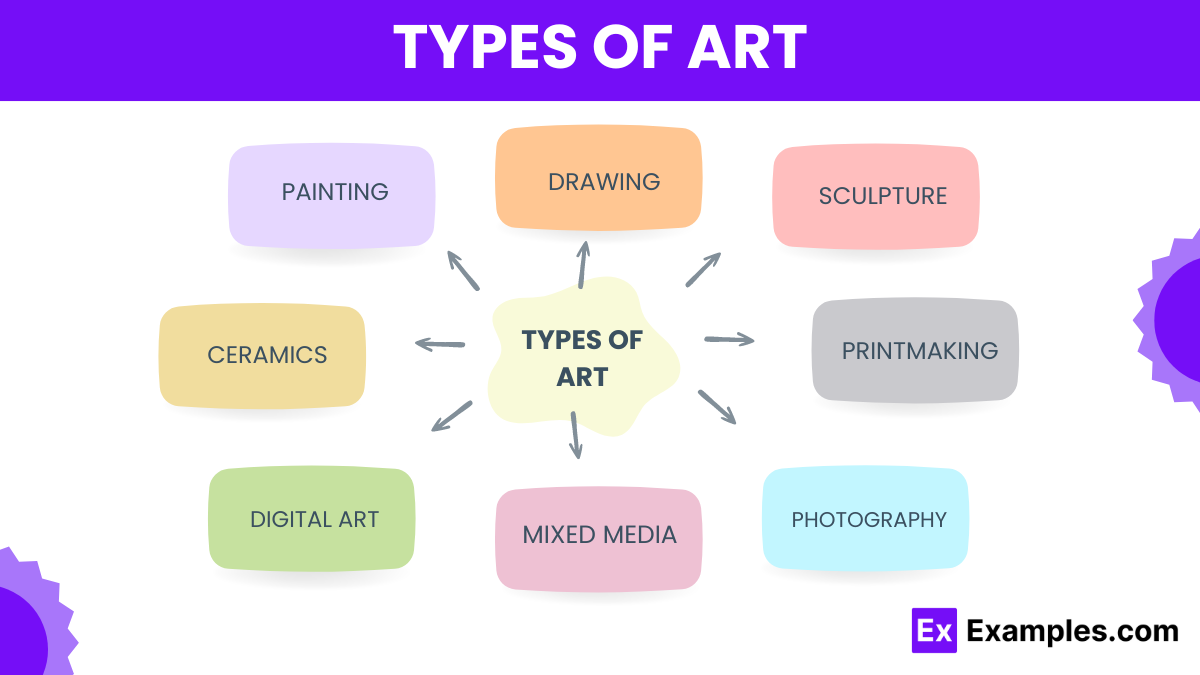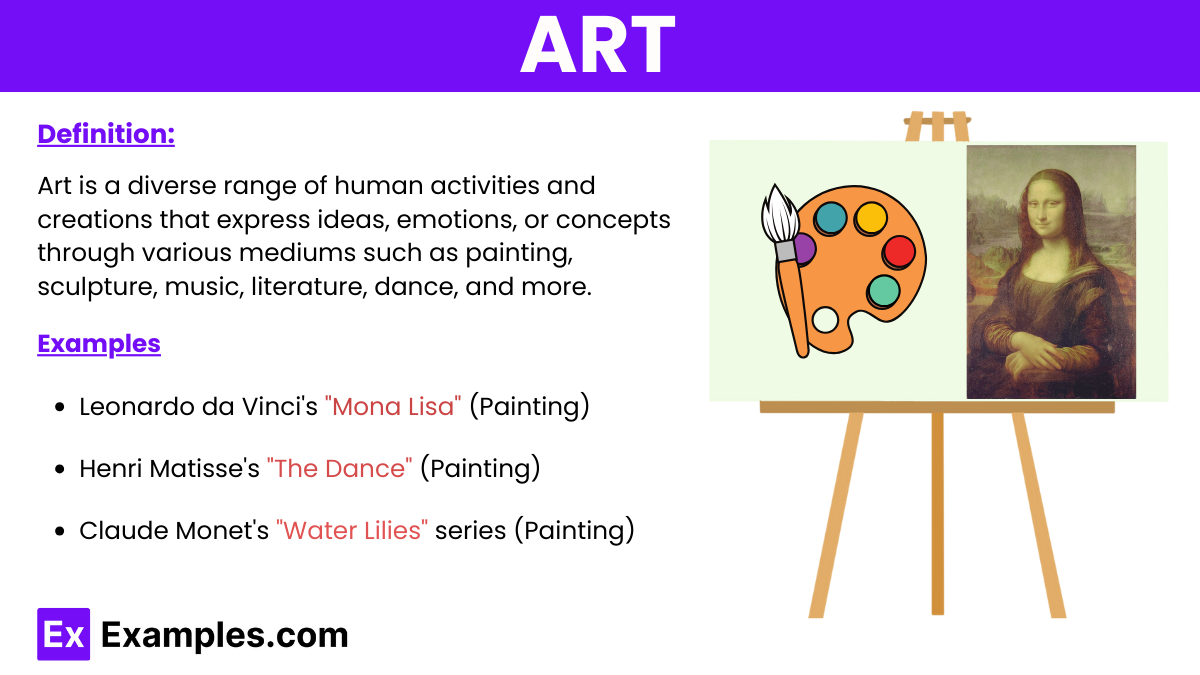Art – Definition, Types, Examples, Uses
In English language skills, “art” refers to the expression or application of human creative skill and imagination, typically in visual forms such as painting, drawing, sculpture, and other forms of visual art. It encompasses a wide range of creative activities that aim to evoke emotions, convey messages, or express ideas through various mediums and techniques.
What is Art?
Art is a diverse range of human activities and creations that express ideas, emotions, or concepts through various mediums such as painting, sculpture, music, literature, dance, and more. It is characterized by creativity, imagination, and skillful execution, with the intention of stimulating the senses, intellect, or emotions of the audience. Art serves various purposes, including communication, expression, reflection, and exploration of cultural, social, or personal themes. Ultimately, art is a fundamental aspect of human culture and identity, shaping our perceptions, experiences, and understanding of the world around us.
Art Drawing
Art drawing encompasses a vast array of techniques and styles used to create visual representations on surfaces such as paper, canvas, or digital platforms. It involves the use of various tools such as pencils, pens, charcoal, pastels, or digital software to convey ideas, emotions, or observations. Drawing can range from realistic renderings to abstract interpretations, allowing artists to explore and experiment with line, form, texture, and composition. Whether it’s capturing the delicate details of nature, expressing inner thoughts and feelings, or simply documenting daily life, drawing serves as a versatile medium for artistic expression and communication. Through the skillful manipulation of lines, shapes, and values, artists can evoke powerful imagery that resonates with viewers, transcending language and cultural barriers to create a shared experience of beauty and meaning.
Art Painting
Art painting is a rich and diverse form of artistic expression that involves applying pigments to a surface, typically canvas, paper, or wood, using brushes, palette knives, or other tools. It encompasses a wide range of styles, techniques, and subjects, from realistic portrayals to abstract interpretations. Artists use various types of paints such as acrylics, oils, watercolors, or gouache to create visually captivating compositions that convey emotions, ideas, or narratives. Painting allows artists to explore color, texture, light, and form, capturing the essence of their subjects and imbuing their work with personal meaning. Whether it’s capturing the beauty of landscapes, depicting the complexity of human emotions, or experimenting with avant-garde concepts, art painting serves as a powerful means of creative expression and communication, engaging viewers on both intellectual and emotional levels.
Types of Art

Painting: This involves applying pigments to a surface, such as canvas or paper, using brushes, palette knives, or other tools. Painting encompasses various styles and techniques, including oil painting, watercolor, acrylics, and gouache.
Drawing: Drawing involves creating images using lines and marks on a surface, typically with pencils, pens, charcoal, or pastels. It encompasses a wide range of styles and approaches, from realistic sketches to abstract compositions.
Sculpture: Sculpture is the art of creating three-dimensional forms by shaping or carving materials such as stone, wood, metal, clay, or plaster. Sculptures can be representational or abstract and can vary in size from small-scale works to monumental installations.
Printmaking: Printmaking is a process of creating artworks by transferring images from a matrix, such as a woodblock, metal plate, or screen, onto paper or other surfaces. Common printmaking techniques include woodcut, etching, lithography, and screen printing.
Photography: Photography involves capturing and recording images using cameras and photographic equipment. It encompasses various genres, including portrait, landscape, documentary, and experimental photography, and can range from traditional film-based techniques to digital imaging.
Mixed Media: Mixed media art involves using a combination of different materials and techniques to create artworks. Artists may incorporate elements such as collage, assemblage, found objects, and textural layers to explore themes and create visually dynamic compositions.
Digital Art: Digital art is created using digital technologies, such as computers, tablets, and software programs. It encompasses various forms, including digital painting, digital drawing, computer-generated imagery (CGI), and interactive installations.
Performance Art: Performance art involves live presentations or actions by artists, often incorporating elements of theater, dance, music, and visual arts. Performance artists use their bodies, movements, and gestures to convey ideas, emotions, and narratives to an audience.
Installation Art: Installation art is a genre of contemporary art that involves creating immersive environments or site-specific installations using a combination of materials, objects, and spatial elements. These artworks are often designed to engage viewers physically and intellectually.
Ceramics: Ceramics is the art of creating objects from clay or other ceramic materials by shaping, molding, and firing them in a kiln. It encompasses various techniques, including handbuilding, wheel throwing, and glazing, and can result in functional objects such as pottery and sculptural forms.
Uses of Art
Art serves a multitude of purposes across cultures and societies, enriching various aspects of human life. Some of the key uses of art include:
- Expression: Art provides a means for individuals to express themselves creatively, conveying emotions, thoughts, and experiences through visual, auditory, or performative mediums. It serves as a vehicle for personal expression and introspection, allowing artists to communicate ideas and perspectives that may be difficult to articulate through words alone.
- Communication: Art transcends language barriers and communicates across cultural, social, and geographical divides. It serves as a universal language, enabling people to connect and empathize with others through shared experiences and interpretations of artistic works.
- Reflection: Art encourages reflection and introspection, prompting viewers to contemplate complex themes, ideas, and issues. It stimulates critical thinking and fosters dialogue about societal norms, values, and challenges, encouraging individuals to question and explore their beliefs and assumptions.
- Education: Art plays a vital role in education, fostering creativity, imagination, and cognitive development in learners of all ages. It provides opportunities for hands-on learning, experimentation, and problem-solving, enhancing skills such as observation, interpretation, and analysis.
- Cultural Preservation: Art preserves and celebrates cultural heritage, traditions, and identities. It serves as a repository of historical knowledge and cultural practices, documenting the stories, beliefs, and customs of diverse communities for future generations.
- Entertainment: Art entertains and engages audiences, providing enjoyment, pleasure, and inspiration through visual arts, literature, music, theater, film, and other forms of creative expression. It enriches leisure experiences and contributes to the overall well-being and quality of life.
- Therapy: Art therapy harnesses the healing power of art to promote emotional, psychological, and physical well-being. It provides a non-verbal outlet for individuals to process trauma, reduce stress, and improve self-awareness, self-esteem, and coping skills under the guidance of trained therapists.
- Social Commentary: Art serves as a platform for social commentary and activism, addressing pressing issues such as inequality, injustice, environmental degradation, and human rights violations. It inspires advocacy, raises awareness, and mobilizes communities to effect positive change.
- Economic Impact: Art contributes to economic development and prosperity through creative industries such as visual arts, design, fashion, advertising, and entertainment. It generates employment, tourism, and revenue, revitalizes communities, and fosters innovation and entrepreneurship.
- Inspiration and Beauty: Art inspires awe, wonder, and appreciation for the beauty and diversity of the world. It uplifts spirits, sparks imagination, and cultivates a sense of wonder and curiosity about the human experience and the mysteries of existence.
Examples of Art
- Leonardo da Vinci’s “Mona Lisa” (Painting)
- Michelangelo’s “David” (Sculpture)
- Vincent van Gogh’s “Starry Night” (Painting)
- Pablo Picasso’s “Guernica” (Painting)
- Banksy’s Street Art (Graffiti)
- Maya Lin’s Vietnam Veterans Memorial (Sculpture/Installation)
- Georgia O’Keeffe’s “Red Poppy” (Painting)
- Auguste Rodin’s “The Thinker” (Sculpture)
- Claude Monet’s “Water Lilies” series (Painting)
- Keith Haring’s “Untitled” (Drawing)
- Frida Kahlo’s “Self-Portrait with Thorn Necklace and Hummingbird” (Painting)
- Andy Warhol’s “Campbell’s Soup Cans” (Pop Art)
- Jackson Pollock’s “Number 1A, 1948” (Abstract Expressionism)
- Damien Hirst’s “The Physical Impossibility of Death in the Mind of Someone Living” (Installation)
- Marina Abramović’s “The Artist is Present” (Performance Art)
- Rembrandt’s “The Night Watch” (Painting)
- Anish Kapoor’s “Cloud Gate” (Sculpture)
- Henri Matisse’s “The Dance” (Painting)
- Cindy Sherman’s “Untitled Film Stills” series (Photography)
- Salvador Dalí’s “The Persistence of Memory” (Surrealism)
FAQs
What is the difference between art and the arts?
Art refers to individual works or expressions within various creative disciplines, while the arts encompass a broader spectrum of artistic endeavors, including visual arts, performing arts, and literary arts.
Why is painting harder than drawing?
Painting often involves additional complexities such as color mixing, layering, and mastery of various techniques, requiring more technical skill, practice, and understanding of composition compared to drawing.
How has technology impacted art?
Technology has revolutionized the production, distribution, and consumption of art, enabling new forms of digital art, interactive installations, virtual reality experiences, and online platforms for sharing and collaboration.
Can anyone be an artist?
Yes, anyone can engage in artistic expression and creativity regardless of age, background, or skill level. The definition of “artist” is inclusive and encompasses a wide range of individuals who engage in creative activities and self-expression.



